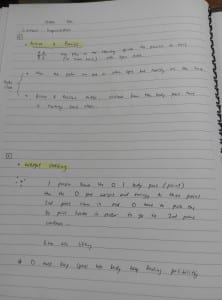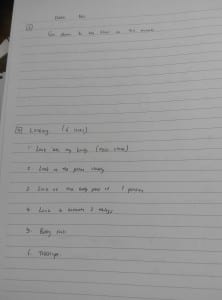HOLD IT AGAINST ME by Jennifer Doyle
CHAPTER 1 – INTRODUCING DIFFICULTY
Our faculties break down when an artwork reminds us of something so painful, or makes us so mad, or is something we like so much. Writer in a way tries to tell us that difficult is because every human being has his own limit in certain thing.
The writer is looking at the difficulty that many of us have with come forms of contemporary art and the centrality of emotion to that kind of difficulty.
Emotion is one of the main factor that make our experience of art harder, but that experience become more interesting.
Doyle came out with many questions that related to feeling that is impossible to answer, such as: does a feeling come from inside the spectator of from the artwork? does an artwork represent feeling? does a work makes feeling?how?
She used the example of film and live performance of art and compared them. Why is it easier for us to watch an upsetting movie than it is to keep company with contemporary art that makes similar emotional demands on us? I somehow think that the reason could be the live event of contemporary art looks more real and more close to us. Film contain less realness maybe?
‘The difficulty of meaning, is packaged as cool, distanced, and anti-emotional.’
The writer has mentioned many situations about the government and politic that having difficulty to accept certain artworks (that relates to homosexualities for example) and not willing to give support to the performance. The expression of specific points of view become stunted as institutions hesitate to support challenging work and as artist anticipate censorious attention.
‘is it art, or it is a crime?’ all these have shown the limitation (which crewe difficulty) of acceptance by different human being in different position (government, religious people, artist, conservative people…) that created many thought, question, reaction.
Some artists created artwork with the intentions to challenge their audiences. Somehow leave us unsure of how to react, confused about our own emotions and the place of those feelings in relation to the work itself.
underground artists are underground precisely because their work off the disciplinary grid, spatially and conceptually. Work out commercial space.
The key points of the difficulty of the artworks are tied to their emotional and identificatory geomatries( like we see blood in live performance, some of us panic, but people that work in hospital which often see blood and for them it is normal, they might not feel panic at all).
CHAPTER 2: TOUCHY SUBJECT: RON ATHEY, Incorrruptible Flesh
In this performance, Athey was putting himself in a pain situation where he pierced his face in multiple points and hooked them up above his head, and turned his face into a painful mask. Audience is allow to wear glove and touch his body if they want to.
Amelia Jones thinks that his performance as an ‘ethics of embodiment’ that begins with the dehabituation of the body. He represented his body as penetrable, leaking and vulnerable.
The body is presented aggressively to the viewer, yet audience access to it is strictly regulated.
Many writer and magazine refuse or did not write about Athey’s work because they found it difficult to critic. Not in the range of what they able to write somehow. Can say that his works challenge art critic to write about them.
THE QUEER ART OF FAILURE
CHAPTER 4 SHADOW FEMINISMS: QUEER NEGATIVITY & RADICAL PASSIVITY
Freud famous question: What do women want?
Writer talked about woman and feminism. She speaks about Hindu widow where there were many widows commit suicide after her husband death, to avoid herself live as a widow (degradation, being humiliate)
The writer used the example of Chicken Run, ‘we either die free chickens, or we die trying.’ but another hen replied, ‘Are those the only choices?’ Reflecting : feminist refuse the choices as offered – in order to think about a shadow archive of resistance, one that does not speak in the language of action and momentum but instead articulates itself in terms of evacuation, refusal, passivity. – antisocial feminism.
Collage seems feminist and queer. Collage, has been used by many female artist, to bind the threat of castration to the menace of feminist violence and both to the promise of transformation, not through a positive production of the image but a negative destruction of it.
Looking at Kara Walker’s work, they are catalogues of both racial violence and the erasure of such violence through the theoretical association of art with beauty. She used art as bait and deploying the female body in particular as a site for the negative projection of racial and colonial fantasy. For the writer, Walker used art to turn racism and sexism as a mirror is call Feminist Negation. Writer also thinks that artworks like Cut Piece by Yoko Ono and Rhythm 0 by Marina Abramovic were not rescuing the woman; rather they hang her out to dry as woman. Or instead make feminism into sacrifice.
From what I understand about radical passivity they writer explained through the works of Marina and Ono, offer an antisocial way out of the double bind of becoming woman and thereby propping up/strengthen the dominance of man within a gender binary.
Masochism, represents a deep disruption of time, tension between pleasure and death. Like The Cut Piece, offers quiet masochistic gesture, the refuse to resist, to be cut to be bared, to be violated publicly. Think it as the site of failure.
UGLY FEELING by SIANNE NGAI
Introduction
Ngai shows how art turns to ugly feelings as a site for interrogating its own suspended agency in the affirmative culture of a market society, where art is tolerated as essentially unthreatening.
The aesthetics of negative emotion, in literature, film and theoretical writing to explore similar ambivalent (unsure) situations of suspended agency.
This book approaches emotions as unusually condensed ‘interpretations of predicament (difficult situation)’ – signs that not only render visible different registers of problem but conjoin these problems in a different manner. Focus on the negative effects that read the predicaments posed by a general state of obstructed (blocked) agency.
Envy (of the disempowered for the powerful)
Paranoia (about one’s perceived status as a small subject in a ‘total system’)
Fear is transformed into n operational requirement. a special tool of the trade. Fear of losing recently gained privileges, anxiety over being left behind translate into a reconfigure (readjust) oneself.
These noncathartic feelings in this book could give rise to a non cathartic release(suspended action) and does so as a kind of politics.
Synthesis of boredom and shock, she called ‘stuplimity’.
A special relationship between ugly feelings and irony. These feeling tends to produce an unpleasurable feeling about the feeling. For example: I feel ashamed about feeling envious. the doubleness. Irony – between the said and the unsaid.
Anger – centrality to the pursuit of social justice.
Irritation – an inadequate form of the anger.
PRACTICAL PREPARATION
The work I have chosen is Given Over To Want by Nao Bustamante.
The reason I choose this performance is because it interests me in many ways and I found it relevant to the reading for Embracing Failure. Firstly, I am interested with her ‘ugly’ body (fat, oversized) which has somehow represent her failure of having ‘perfect’ body shape like the expectations from the society. Secondly, I feel it is interesting that she changed her look into alien-like and her look allows you to imagine as you like. Thirdly, I see the what I think is abjection on her performance in Given Over To Want. She humiliated herself by dressing herself in an ugly way, with tapes, white clothe, fruits (as her high heels shoes), wine in a box was sticked on her head and etc. There was a moment that she started crawling on the floor, it gave me an image of an animal (dog perhaps) and at the same time trying to drink the wine that dripped out from the wine box above her head. This image was so disturbing me, it was totally abject in herself and self-degradation as a fat woman acting like an animal to me.
Many negative feelings emerged in me while watching the video. Distraction, embarrassment, disturbing, curious, disgust and maybe more.
There was expectation while watching her performance, to see her bare body and show her fatness. When the wine was dripped out, it makes the white clothe turn into partially transparent especially her breast. I expected she get herself half naked or something but she did not do that.
I really like the way she turns those props into her costume. I think it was so creative, especially the fruits above and under her feet. The way she taped herself with those props was interesting to me as well. I thought it was a good strategy to used those props to change her shape/look into something different.
Everyone wants to look beautiful or more beautiful, Bustamante was completely the other way round. She makes her ugliness (fatness) more ugly and challenge her limitation of ugliness. Never afraid of show it out. In a way, she has create her own ‘Freak Show’.
I have taken the idea from Mario Banana by Andy Warhol and combined it with the inspirations from Given Out To Want.

